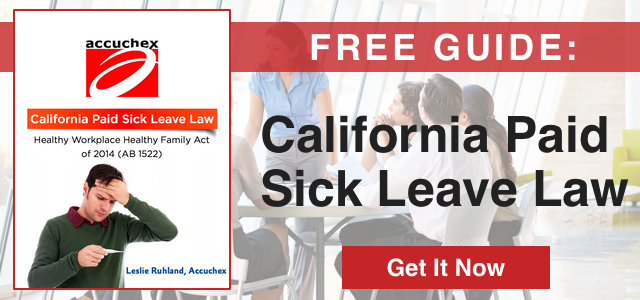As California employers enter into the second quarter of 2017, compliance with California labor laws may not be a priority. But complying with the California Paid Sick Leave Law is critical.

[A portion of this article was published here in a previous post.]
California employers must deal with a myriad of labor laws and the challenge of compliance. And each year brings new regulations. When it comes to labor law, California tends to be one of the most rigorous states and, some employers would say, most onerous.
A good example of these types of labor laws is the current sick leave law that was updated almost two years ago.
The Healthy Workplaces, Healthy Families Act of 2014 (AB 1522), also known as the Paid Sick Leave Law, was amended in July 2015 by Governor Jerry Brown when he signed Assembly Bill 304. A number of significant changes were effected and new compliance requirements put into place.
At that time, the Department of Industrial Relations (DIR) updated their FAQ list which they had first posted back in February 2015, in response to the new changes in the California sick leave law,
The qualifying periods that determine which employees are eligible for paid sick leave and the employee notice required by Labor Code 2810.5 became effective on January 1, 2015 and actual entitlement began on July 1st of 2015.
By now, most employers in California should have already implemented all the required processes and posted notices, issued forms, and verified compliance with the law.
The Law Applies to Most Businesses in California
In a recent article. the CalChamber Advocacy noted that,
Even though the paid sick leave law received a lot of press, some businesses still seem surprised about the new law, perhaps thinking it does not apply to them.
Unlike other leave laws, such as the California Family Rights Act (CFRA) or federal Family and Medical Leave Act (FMLA), there is no size requirement before the PSL law applies to a company. The law applies to all employers, big and small.
Moreover, PSL must be provided to all types of employees: part-time, hourly, temporary, seasonal, exempt and nonexempt. Any employee who has worked in California for the same employer for 30 or more days within one year from the beginning of his/her employment will be entitled to PSL.
The details of AB 304 are quite extensive, but there are a certain points that all businesses need to be familiar with.
[The following section has been published here in a previous post, but it bears repeating as some businesses in California are still not fully in compliance with the current California Sick Leave Law.]
California Sick Leave Law Employer Requirements
The Department of Industrial Relations (DIR) updated FAQs reflect the new requirements under AB 304. The changes that have resulted from the amendments to the new paid sick leave law first became effective on July 13, 2015.
In addition to these new employer requirements, the updated FAQs also clarify previous responses to specific questions regarding the paid sick leave law.
Required information to be provided by employers:
Unfortunately, California labor laws tend to increase operational costs for California employers and businesses.
In addition, they also add more regulatory and compliance demands on HR staff that are often already overwhelmed with government regulations. The Paid Sick Leave Law and its amendments under AB 304 are no different.
Here are the major changes that impact compliance with notification for employers:
1. Notification of rights to paid sick leave for employees
Beginning January 1, 2015, employers have been required to display a poster in a conspicuous place at the workplace.
The workplace posting must contain the following information:
- That an employee is entitled to accrue, request, and use paid sick days;
- The amount of sick days provided for and the terms of use of paid sick days;
- That retaliation or discrimination against an employee who requests paid sick days or uses paid sick days or both is prohibited; and
- That an employee has the right under this law to file a complaint with the Labor Commissioner against an employer who retaliates or discriminates against an employee
The new law required the Labor Commissioner to develop such a poster, which is available from the Labor Commissioner’s website.
Since January 1, 2015, employers are required to provide most employees with an individualized Notice to Employee (required under Labor Code section 2810.5) that includes paid sick leave information. A Notice to Employee form revised to reflect the new sick leave law by the Labor Commissioner’s Office must be used for employees hired after January 1, 2015.
For any employees that were hired prior to January 1, 2015, the employer is required to provide a revised Notice to Employee or otherwise inform each employee of the information regarding paid sick leave, by using any of the alternative methods specified in Labor Code section 2810.5(b).
Note: The Notice to Employee provisions of Labor Code section 2810.5 do not apply to exempt employees, most government employees, or to employees covered by a valid collective bargaining agreement that meets certain specifications.
2. If an employer’s policy has different terms from the paid sick leave law
The state law providing for paid sick leave only creates minimum standards for paid sick leave. Employers may use their existing policies so long as the policy complies with the minimum requirements of the law.
The revised Notice to Employee form includes a check box to inform an employee of an employer’s own existing paid time off or paid sick leave policy that meets or exceeds the requirements of the new law. It is important to review and compare existing policy to the standards of the paid sick leave law.
To avoid misinformation or misunderstanding regarding an employer’s paid time off or paid sick leave policy, employers are encouraged to ensure that employees are made fully aware of the terms and conditions of their policy.
Although the notice requirements of Labor Code section 2810.5 do not apply to employees who are exempt from the payment of overtime, employees who are exempt from the payment of overtime are covered by the new paid sick leave law.
3. Notice to Employees forms for employees who were hired prior to January 1, 2015
In general, employers must provide new notices to workers hired prior to January 1, 2015. Unless the notice requirement in Labor Code section 2810.5 does not apply (exempt employees, public employees, and employees covered under certain collective bargaining agreements are excluded), or if the paid sick leave does not apply under one of the exceptions stated in Labor Code section 245.5(a), an employer must notify all employees hired prior to January 1, 2015 of changes to terms and conditions of employment that relate to paid sick leave within 7 days of the actual change.
A revised Notice to Employee may be used for providing individual notice to these existing employees unless the employer chooses an authorized alternative method.
4. Providing sick leave law information in businesses where existing sick leave policies remain unchanged
Although an existing paid sick leave or paid time off policy may already satisfy the minimum requirements of the law, and the policy may have been previously provided to an employee or contained in an employer's policy manual available to employees), employers must still provide some form of notice of the employee’s rights under the new law.
The Labor Commissioner’s Office has advised employers that it is a best practice to provide an individual notice containing information about the new paid sick leave law on the revised DLSE notice form to existing employees.
Whether an employer elects to use the DLSE revised form or another kind of written document, such notice must contain information about the employee’s rights under new paid sick leave law, and ideally should include details on how the employer intends to meet the requirements of the new law for the particular employee.
For example, a written statement provided to the employee which refers to or summarizes the employer’s existing sick leave policy and contains the points of information as specified in the revised notice form that is provided to each employee would be the recommended best practice.
Staying Informed and Employer Due Diligence
Compliance by employers, especially with issues such as California sick leave law requirements, means having an ongoing and up-to-date process for tracking, understanding, and implementing the provisions of these laws.
There are a number of resources that can assist with this process such as CalChamber’s HRCalifornia site. A good payroll management services company that also provides Human Resources and Insurances services, such as Accuchex Payroll Management Services, is a great option to consider.
Get your Free Guide: California Paid Sick Leave Law to help you make an informed decisions or call Accuchex Payroll Management Services at 877-422-2824.



